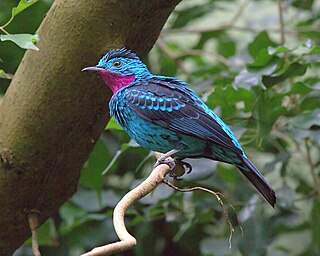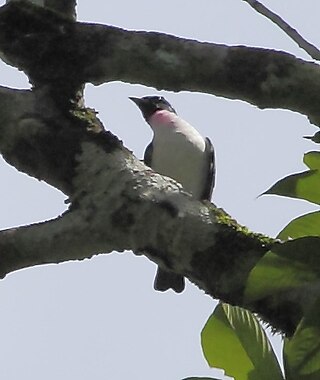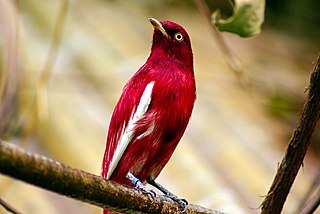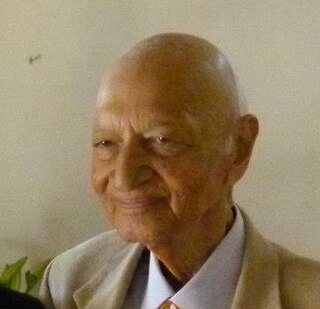Related Research Articles

Birdwatching, or birding, is the observing of birds, either as a recreational activity or as a form of citizen science. A birdwatcher may observe by using their naked eye, by using a visual enhancement device such as binoculars or a telescope, by listening for bird sounds, watching public webcams, or by viewing smart bird feeder cameras.

The cotingas are a large family, Cotingidae, of suboscine passerine birds found in Central America and tropical South America. Cotingas are birds of forests or forest edges, that are primary frugivorous. They all have broad bills with hooked tips, rounded wings, and strong legs. They range in size from 12–13 cm (4.7–5.1 in) of the fiery-throated fruiteater up to 48–51 cm (19–20 in) of the Amazonian umbrellabird.

The American Birding Association (ABA) is a nonprofit organization, founded in 1969, dedicated to recreational birding in Canada and the United States. It has been called "the standard-bearer for serious birding in North America." Originally concentrated on finding, listing, and identifying rare birds, the ABA now seeks to serve all birders with a wide range of services and publications.

The ashy prinia or ashy wren-warbler is a small warbler in the family Cisticolidae. This prinia is a resident breeder in the Indian subcontinent, ranging across most of India, Nepal, Bangladesh, eastern Pakistan, Bhutan, Sri Lanka and western Myanmar. It is a common bird in urban gardens and farmlands in many parts of India and its small size, distinctive colours and upright tail make it easy to identify. The northern populations have a rufous rump and back and have a distinct breeding and non-breeding plumage while other populations lack such variation.

Sálim Moizuddin Abdul Ali was an Indian ornithologist and naturalist. Sometimes referred to as the "Birdman of India", Salim Ali was the first Indian to conduct systematic bird surveys across India and wrote several bird books that popularized ornithology in India. He became a key figure behind the Bombay Natural History Society after 1947 and used his personal influence to garner government support for the organisation, create the Bharatpur bird sanctuary and prevent the destruction of what is now the Silent Valley National Park.

Glamorgan Bird Club is based in Glamorgan in South Wales, and is dedicated to the study and conservation of the avifauna of Eastern Glamorgan which is the club's bird 'recording area'. This comprises the Counties of Caerphilly, Merthyr Tydfil, Cardiff, Rhondda Cynon Taf, Vale of Glamorgan, and Bridgend).

The long-wattled umbrellabird is an umbrellabird in the Cotingidae family. Its Spanish names include pájaro bolsón, pájaro toro, dungali, and vaca del monte. The long-wattled umbrellabird is considered rare and it resides in humid to wet premontane and cloud forest. They are often found on the Pacific slopes of southwest Colombia and western Ecuador, but occasionally are found at lower altitudes.

The black-faced hawk is a species of bird of prey in the family Accipitridae. This low-density species has traditionally been believed to be restricted to Amazon Basin north of the Amazon River, but there are several records south of this river, in, for example, the Brazilian states of Pará and Acre, and southeastern Peru. It is closely related to the white-browed hawk and individuals showing a level of intermediacy between the two species are known, suggesting that they rarely hybridize

The spangled cotinga is a species of bird in the family Cotingidae, the cotingas. It is found in the canopy of the Amazon Rainforest in South America.

The black-tailed myiobius or black-tailed flycatcher is a species of passerine bird in the family Tityridae. It was previously placed in the family Tyrannidae. Black-tailed flycatchers are found in Brazil, Colombia, Costa Rica, Ecuador, Panama, Peru, and Venezuela. Their natural habitats are subtropical or tropical moist lowland forests and heavily degraded former forest. They are usually found alone or in pairs, but may join flocks of several species.

The swallow-tailed cotinga is a species of passerine bird in the family Cotingidae. It is the only member of the genus Phibalura.

The purple-throated cotinga is a species of bird in the cotinga family, Cotingidae. It is found in the western Amazon rainforest of South America; its range extends from southern Colombia south through eastern Ecuador and Peru and east through extreme northwestern Bolivia and into western Amazonian Brazil. It lives in the canopy or along the borders of humid forest throughout its range. The purple-throated cotinga is monotypic within the genus Porphyrolaema and has no known subspecies. It is one of the smaller cotinga species and expresses strong sexual dimorphism. Males have black upperparts with a bold white wingstripe and white edges to the tertial feathers and a white belly with some black barring on the rear flanks. The throat is a deep purple, giving the bird both its common and scientific names. Females are dark brown with pale buffy margins on the upperparts, buffy cinnamon with black barring on the underparts, and rufous on the throat. The male has a powerful voice.

The purple-throated fruitcrow is a species of bird in the family Cotingidae, the cotingas. It is the only species of the genus Querula. It is native to Nicaragua, Costa Rica, Panama, and most of the northern half of South America, its habitat being humid lowland forest where it feeds mainly on insects and fruit. It is a glossy black, medium-sized bird and the male has a purple-red throat patch. It nests in close vicinity with other birds of its species. Its population is in decline, but it is a common species with a very wide range, and the International Union for Conservation of Nature has assessed its conservation status as being of "least concern".

The black-and-gold cotinga is a species of bird in the family Cotingidae. It is endemic to humid Atlantic Forest in the highlands of the Serra do Mar in south-eastern Brazil. It is threatened by habitat loss, but remains common within several national parks, e.g. Serra dos Órgãos and Itatiaia. Males are highly vocal, and their loud, piercing whistle is frequently heard. It is strongly sexually dimorphic. Except for a bright yellow wing-speculum, males are superficially similar to the male common blackbird, while the far less conspicuous females are overall olive. The female resemble both sexes of the only other member of the genus, the grey-winged cotinga, but is larger, has a thicker bill, and yellowish-olive remiges.

The pompadour cotinga is a species of bird in the family Cotingidae. This species lives in the Amazonian rainforest and has a range that extends across the Amazon Basin and includes Brazil, Peru, Colombia, Venezuela, and the Guianas. The pompadour cotinga is primarily a frugivore but has been known to consume insects on occasion. This species of cotinga is distinct in that the males have a burgundy head and body, bright white wings, and yellow eyes. Like other members of the Cotingidae, this species is sexually dimorphic and the females have a pale grey head and body. Although there are not many documented observations of the nesting behavior of these birds, the males are known to perform elaborate mating displays for the females who then raise the young alone.

Tityridae is family of suboscine passerine birds found in forest and woodland in the Neotropics. The 45 species in this family were formerly spread over the families Tyrannidae, Pipridae and Cotingidae. As yet, no widely accepted common name exists for the family, although tityras and allies and tityras, mourners and allies have been used. They are small to medium-sized birds. Under current classification, the family ranges in size from the buff-throated purpletuft, at 9.5 cm (3.7 in) and 10 grams, to the masked tityra, at up to 24 cm (9.5 in) and 88 grams. Most have relatively short tails and large heads.

The Gower Ornithological Society is a society for professional and amateur birdwatchers covering the geographical areas of south Wales comprising Gower, Swansea, Neath and Port Talbot.

Zafar Rashid Futehally was an Indian naturalist and conservationist best known for his work as the secretary of the Bombay Natural History Society and for the Newsletter for Birdwatchers a periodical that helped birdwatchers around India to communicate their observations. Awarded Padma Shri by the Government of India in the year 1971, Zafar Futehally was also honoured with Dutch order of merit the Order of the Golden Ark in 1981 and Karnataka Rajyotsava award by the Government of Karnataka in 1983.
James Vanderbeek "Van" Remsen Jr. is an American ornithologist. His main research field is the Neotropical avifauna. In 1999, he founded the South American Classification Committee. In 2013, he was honored with the Brewster Medal of the American Ornithologists' Union.

The Apolo cotinga or palkachupa cotinga is a species of passerine bird in the family Cotingidae. It is a member of the genus Phibalura.
References
- ↑ Ridgely, Robert S.; Guy Tudor (2009). Field Guide to the Songbirds of South America: The Passerines. University of Texas Press. p. 5. ISBN 978-0-292-71979-8.
In recent years the Neotropical Bird Club has come to play a role as well, not only by publishing the journal Cotinga but also increasingly by supporting direct conservation efforts.